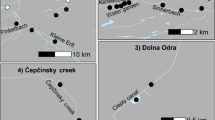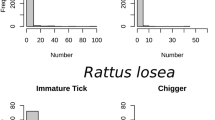Abstract
Prevalence and temporal evolution of the infection by the acanthocephalan Macracanthorhynchus hirudinaceus is studied in the Valencian Community (Eastern Spain), a region only recently fully colonized by the expanding native Eurasian wild boar (Sus scrofa). For 8 years, a total of 1486 wild boars were sampled in order to look for the parasite. The mean prevalence was 20.7% (95% CI, 18.6–22.8; 307/1486). We observed an increasing trend through time, both in the number of wild boars and affected districts. The prevalence of M. hirudinaceus rose in parallel to the annual capture of wild boars, and its presence has been expanding towards the East. A hotspot of M. hirudinaceus is located to the west of the study area, in Muela de Cortes Game Reserve, where 89.6% of the wild boars were positive for the infection, constituting one of the world’s highest known prevalence areas.




Similar content being viewed by others
Data availability
Additional data and materials are available under reviewers’ request.
References
Abraham J, Giacomuzzi V, Angeli S (2015) Root damage to apple plants by cockchafer larvae induces a change in volatile signals below- and above-ground. Entomol Exp Appl 156:279–289. https://doi.org/10.1111/eea.12330
Acevedo P, Vicente J, Höfle U, Cassinelo J, Ruiz-Fons F (2006) Estimation of European wild boar relative abundance and aggregation: a novel method in epidemiological risk assessment. Epidemiol Infect 135:519–527
Anguix A, Díaz L (2008) gvSIG: A GIS desktop solution for an open SDI. J Geogr Reg Plann 1:041–048
Barbosa JD, Silva JB, Reis ASB, Bomjardim HA, Driemeier D (2017) Identification of Macracanthorhynchus hirudinaceus, Stephanurus dentatus and Trichuris suis in native pigs of Marajó Island. J Vet Sci Med Diagn 6:4. https://doi.org/10.4172/2325-9590.1000237
BDB (2017) Banco de Datos de Biodiversidad de la Comunidad Valenciana http://www.bdb.gva.es/va/buscador
Boitani L, Mattei L (1992) Aging wild boar (Sus scrofa) by tooth eruption. In: Spitz F, Janeau G, Gonzalez G, Aulagnier S (eds) Ongulés/Ungulates. S.F.E.P.M.-I.R.G.M, París-Toulouse, pp 419–421
Brianti E, Gaglio G, Ferlazzo M, Abbene S, Poglayen G, Gianetto S (2007) A review of parasites found in the Sicilian Black Pig. Proceedings of the 6th International Symposium on the Mediterranean Pig. October 11-13, 2007. Messina – Capo d’Orlando (ME), Italy
Burgui-Oltra JM, Navas-Almodóvar A, Nieto-Pérez MP (2017) Anexo I: Plan técnico de ordenación cinegética de la Reserva Valenciana de Caza de la Muela de Cortes. Temporadas 2017-18 a 2021-22. Direcció General de Medi Natural i d’Avaluació Ambiental. Generalitat Valenciana. Conselleria d’Agricultura, Medi Ambient, Canvi Climàtic i Desenvolupament rural. 132 pp., pages 52–60
de Estrada MBF (1997) Presentación del primer caso humano de parasitismo por Macracanthorhynchus hirudinaceus en el Perú y breve revisión. Revista Peruana de Medicina Experimental y Salud Publica. ISSN 1726-4634 Rev Peru Med Exp Salud Pública 14:47–50
De-la-Muela L, Hernández-de-Luján S, Ferre I (2001) Helminths of wild boar in Spain. J Wildl Dis 37:840–843
DOGV (2004) Ley 13/2004, de 27 de diciembre, de Caza de la Comunidad Valenciana. Diari Oficial de la Generalitat Valenciana. Núm. 4913 de 29.12.2004
DOGV (2012) ORDEN 3/2012, de 19 de enero, de la Conselleria de Infraestructuras, Territorio y Medio Ambiente, por la que se regula la caza y control del jabalí en la Comunitat Valenciana. Diari Oficial de la Generalitat Valenciana Núm. 6699 de 25.01.2012
Esteve C, Nieto MP (2017) Estadísticas cinegéticas de la Comunitat Valenciana. Memoria anual 2017. Informe interno del Servicio de Caza y Pesca. Generalitat Valenciana
Fernández-de-Mera IG, Gortazar C, Vicente J, Höfle U, Fierro Y (2003) Wild boar helminths: risk in animal translocations. Vet Parasitol 115:335–341
Foata J, Culioli JL, Marchand B (2005) Helminth fauna of wild boar in Corsica. Acta Parasitol 50:168–170
Gassó D, Serrano E, Castillo-Contreras R, Fernández Aguilar X, Colom Cadena A, Velarde R, Mentaberre G, López-Olvera JR, Risco D, Gonçalves P, Lavín S, Fernandez-Llário P, Segalés J, Ferrer D (2016) Coprological tests underestimate Macracanthorhynchus hirudinaceus burden in wild boar. Parasitol Res 115:2103–2105
Geisser H, Reyer HU (2004) Efficacy of hunting, feeding, and fencing to reduce crop damage by wild boars. J Wildl Manag 68:939–946. https://doi.org/10.2193/0022-541X(2004)068[0939:EOHFAF]2.0.CO;2
Giménez-Anaya A, Herrero J, Rosell C, Couto S, García-Serrano A (2008) Food habits of wild boars (Sus scrofa) in a Mediterranean coastal wetland. Wetlands 28:197–203. https://doi.org/10.1672/07-18.1
Hamula CL, Fang DC, Couturier MR (2014) Photo quiz: an unwelcome passenger in a 17-month-old male. J Clin Microbiol 52:2289. https://doi.org/10.1128/jcm.00280-13
Herrero J, García-Serrano A, Couto S, Ortuño VM, García-González R (2006) Diet of wild boar Sus scrofa L. and crop damage in an intensive agroecosystem. Eur J Wildl Res 52:245–250. https://doi.org/10.1007/s10344-006-0045-3
Humbert JF, Henry C (1989) Studies on the prevalence and the transmission of lung and stomach nematodes of the wild boar (Sus scrofa) in France. J Wildl Dis 25:335–341
ICV. Institut Cartogràfic Valencià (2018) Unidades administrativas: Delimitación comarcal en la Comunitat Valenciana. http://descargas.icv.gva.es/server_api/gdb/descarga/index.html?capas = % 22ign_limits.gdb/ign_limcomarcal_pol%22&formato = Shapefile%20-%20SHP%20-%20.shp&g eocat = DATO_DIRECTA_SHP. Accessed on 27 Sept 2019
ICV. Institut Cartogràfic Valencià (2019) Corine Land Cover año 2018. http://www.icv.gva.es/auto/aplicaciones/icv_geocat/#/search?uuid = spa_icv_suelo_corine2018_cv&lang = spa. Accessed on 30 Oct 2019
IGME. Instituto Geológico y Minero de España (2014) Geológico Comunidad Valenciana 400. http://mapas.igme.es/gis/rest/services/Cartografia_Geologica/IGME_GeologicoCValenciana_400/MapServer. Accesed on 12 Oct 2019
Jackson TA, Klein MG (2006) Scarabs as pests: a continuing problem. Coleopt Bull 60(Monogr 5):102–119. https://doi.org/10.1649/0010-065X(2006)60[102:SAPACP]2.0.CO;2
Johnson SN, Nielsen U (2012) Foraging in the dark—chemically mediated host location by root-feeding insects. J Chem Ecol 38:604–614
Kottek M, Grieser J, Beck C, Rudolf B, Rubel F (2006) World map of the Köppen-Geiger climate classification updated. Meteorol Z 15:259–263. https://doi.org/10.1127/0941-2948/2006/0130
Leng YJ, Huang WD, Liang PN (1983) Human infection with Macracanthorhynchus hirudinaceus Travassos, 1916 in Guangdong Province, with notes on its prevalence in China. Ann Trop Med Parasitol 77:107–109. https://doi.org/10.1080/00034983.1983.11811681
Mansouri M, Sarkari B, Mowlavi GR (2016) Helminth parasites of wild boars, Sus scrofa, in Bushehr Province, Southwestern Iran. Iran J Parasitol 11:377–382
Massei G, Kindberg J, Licoppe A, Gačić D, Šprem N, Kamler J, Baubet E, Hohmann U, Monaco A, Ozolin J, Cellina S, Podgórski T, Fonseca C, Markov N, Pokorny B, Rosell C, Náhlik A (2015) Wild boar populations up, numbers of hunters down? A review of trends and implications for Europe. Pest Manag Sci 71:492–500
Mowlavi GR, Massoud J, Mobedi I, Solaymani-Mohammadi S, Gharagozlou MJ, Mas-Coma S (2006) Very highly prevalent Macracanthorhynchus hirudinaceus infection of wild boar Sus scrofa in Khuzestan province, south-western Iran. Helminthologia 43:86–91. https://doi.org/10.2478/s11687-006-0017-x
Nagy G, Ács K, Varga G, Sugár L, Csivincsik Á (2015) Macracanthorhynchus hirudinaceus (Pallas, 1781) larvae in cockchafer (Melolontha spp.) grubs in different habitat conditions. Eur J Wildl Res 61:487–489
Nansen P, Roepstor A (1999) Parasitic helminths of the pig: factors influencing transmission and infection levels. Int J Parasitol 29:877–891
Navarro-González N, Fernández-Llario P, Pérez-Martín JE, Mentaberre G, López-Martín JM, Lavín S, Serrano E (2013) Supplemental feeding drives endoparasite infection in wild boar in Western Spain. Vet Parasitol 196:114–123
Neafie RC, Marty AM (2000) Acanthocephaliasis. In: Meyers WM, Neafie RC, Marty AM and Wear DJ (Eds): Pathology of infectious diseases, vol. 1 helminthiases. Armed Forces Institute of Pathology and American Registry of Pathology, Washington D.C.: 519–529
Reiczigel J, Marozzi M, Fabian I, Rozsa L (2019) Biostatistics for parasitologists – a primer to quantitative parasitology. Trends Parasitol 35:277–281
Reinecke A, Mueller F, Hilker M (2008) Attractiveness of CO2 released by root respiration fades on the background of root exudates. Basic Appl Ecol 9:568–576
Ruiz-Fons F, Segalés J, Gortázar C (2008) A review of viral diseases of the European wild boar: effects of the population dynamics and reservoir role. Vet J 176:158–169
Sarkari B, Mansouri M, Najjari M, Derakhshanfar A, Mowlavi GR (2016) Macracanthorhynchus hirudinaceus: the most common helminthic infection of wild boars in southwestern Iran. J Parasit Dis 40:1563–1566. https://doi.org/10.1007/s12639-015-0728-3
Schmidt GD (1971) Acanthocephalan infections of man, with two new records. J Parasitol 57:582–584. https://doi.org/10.2307/3277920
Senlik B, Cirak VY, Girisgin O, Akyol CV (2011) Helminth infections of wild boars (Sus scrofa) in the Bursa province of Turkey. J Helminthol 85:404–408
Solaymani-Mohammadi S, Mobedi I, Rezaian M, Massoud J, Mohebali M, Hooshyar H, Ashrafi K, Rokni MB (2003) Helminth parasites of the wild boar, Sus scrofa, in Luristan province, western Iran and their public health significance. J Helminthol 77:263–267. https://doi.org/10.1079/joh2003168
Stumpf IVK (1986) Hospedeiros intermediários de Macracanthorynchus hirudinaceus (Pallas, 1781) (Acanthocephala) em Mandirituba, Paraná, Brasil. Acta Biol Parana 15:87–124
Svestka M (2007) Ecological conditions influencing the localization of egg-laying by females of the cockchafer (Melolontha hippocastani F.). J For Sci 53:16–24
Svetska M (2006) Distribution of tribes of cockchafers of the genus Melolontha in forests of the Czech Republic and the dependence of their swarming on temperature. J For Sci 52:520–530
Taylor MA, Coop RL, Wall RL (2015) Veterinary parasitology, 4th Edition. ISBN: 978-0-470-67162-7. Wiley Blackwell. Chichester
Zhong HL, Feng LB, Wang CX (1983) Human infection with Macracanthorhynchus hirudinaceus causing serious complications in China. Chin Med J 96:661–668
Acknowledgements
The authors wish to express their gratitude to Iris García-Bacete and Ismael Pérez-López for their involvement and diligence in field tasks and to Danielle Greenspan and Paul John Schnyder for English language editing and revision. Finally, we would like to thank the two anonymous reviewers for their suggestions and comments.
Funding
This research was partially supported by Banco Santander grant FUSPBS-PPC13/2016 and by Conselleria d’Agricultura, Medi Ambient, Canvi Climàtic i Desenvolupament Rural of Generalitat Valenciana, through the minor contracts 2013/21/187 and 2014/21/112.
Author information
Authors and Affiliations
Contributions
Conceptualization: Victor Lizana, Miguel Angel Sanchez-Isarria
Formal analysis and investigation: Victor Lizana, Raquel Prats, Jesus Cardells
Writing – original draft preparation: Victor Lizana, Maria Jose Carrion, Jesus Cardells
Writing – review and editing: Christian Gortazar
Funding acquisition: Miguel Angel Sanchez-Isarria
Supervision: Christian Gortazar
Corresponding author
Ethics declarations
Conflict of interest
The authors declare that they have no conflict of interest.
Ethics approval
All animal sampling took place post-mortem. The wildlife samples were obtained from hunter-harvested individuals that were hunted independently for our research. According to EU and National legislation (2010/63/UE Directive and Spanish Royal Decree 53/2013) and to the University of Castilla—La Mancha guidelines, no permission or consent is required to conduct the research reported herein.
Bioethics Commission of the CEU Cardenal Herrera University, through report 20/013, decided that no special authorization was necessary, given that the samples were taken post-mortem.
Consent to participate
Not applicable.
Consent for publication
Not applicable.
Code availability
Not applicable
Additional information
Section Editor: Hiroshi Sato
Publisher’s note
Springer Nature remains neutral with regard to jurisdictional claims in published maps and institutional affiliations.
Rights and permissions
About this article
Cite this article
Lizana, V., Gortazar, C., Prats, R. et al. Macracanthorhynchus hirudinaceus in expanding wild boar (Sus scrofa) populations in Eastern Spain. Parasitol Res 120, 919–927 (2021). https://doi.org/10.1007/s00436-020-06975-y
Received:
Accepted:
Published:
Issue Date:
DOI: https://doi.org/10.1007/s00436-020-06975-y




